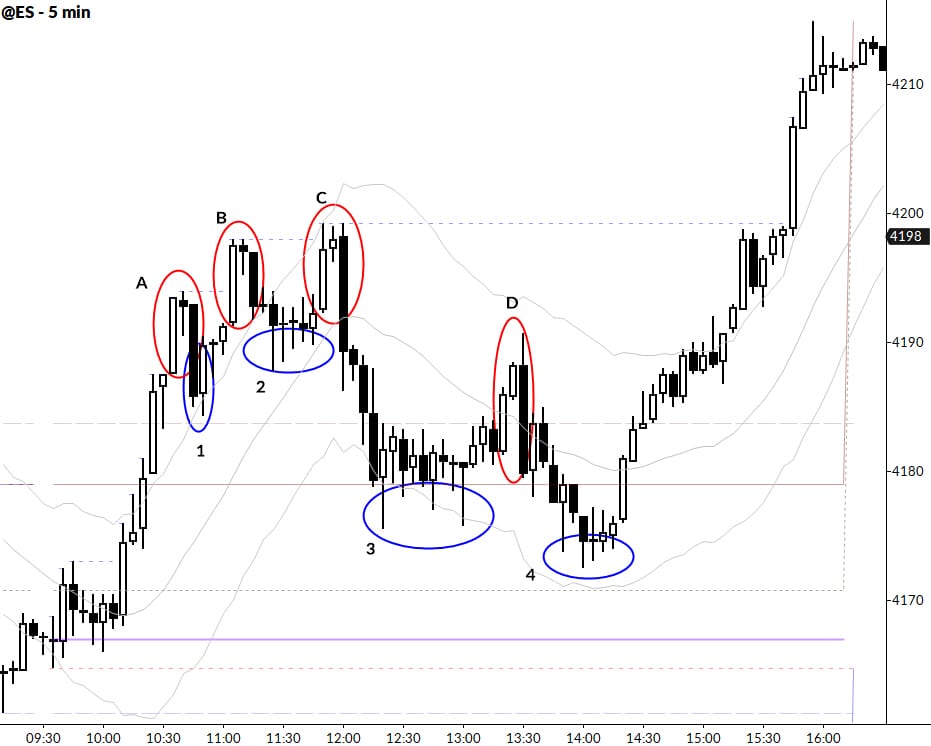Mastering Market Dynamics: Intraday accumulation

Last week's Hudson Sessions talk was centered on the topic of accumulation and distribution. Today, I'd like to share a follow-up lesson that exemplifies these concepts through a trade I recently executed.
On the late afternoon of Thursday, 18th May 2023, I sent a message to Tom, my trading partner, in our chat:
“this market could get dumb into [the] close. I’ve been [offered] up at [420]5.5 for a long time. Thought it was hopeless much of the day lol. Let’s see..”
An explosive setup
At this juncture, the market was already trending towards my profit targets. These were set with an understanding of our PowerLevels and the structure evident on the daily chart. My prediction of potential market volatility towards the close was grounded in typical market behavior. After a day of mostly consolidation, a late-session breakout often leads to substantial continuation. This is driven by a mix of traders exiting shorts, others buying for long-term investment, and a general position adjustment contributing to a robust trend into the close.
Moreover, we've been experiencing an unusually long, sideways range - a period of lackluster trading - and were now on the brink of a breakout. This combination could result in a powerful shift.
This is a common narrative in all markets, but what led to my preemptive positioning? Let's take a look at the chart.
Bearish factors: Understanding the reversal complexes
Firstly, the bearish points marked with letters:
- A and B: These represent near-identical "reversal complexes", a term I use for a series of bars identical to a single candle with a long tail, indicating a failure of buyers.
- C: Another reversal complex, this time followed by aggressive selling. This thrust also completed a three-pushes pattern which often caps a trend in the short term.
- D: A sharp reversal complex, succeeding a rally attempt.
Bullish factors: Spotting signs of accumulation
- 1: A reversal complex offsetting the bearish A complex. This pattern often surfaces when a trend overheats, commonly seen early in the trading session following a clean move off the open. No compelling reason to abandon longs at this point.
- 2: A hint of subtle accumulation. Despite the potential for a third push reversal setup on the next rally (which did, in fact, happen), we would be fully justified in positioning long for a good upside extension. We're aware of the same profit targets that guided my late-day trade and anticipate those key daily levels to act as a magnet on any rally.
- 3: A casual reading of this swing might look very bearish. After all, we just had a convincing lower low and gave up well more than 50% of the day’s range in a few minutes. Furthermore, the open of the session (always a convincing target) is not far below. But any attempt at shorting in this area is quickly met with tails that show accumulation. This is absolutely classic action, and should, at the very least, strongly push you away from the bearish case here.
- 4: Is confusing at first glance: another lower low, and nothing clearly bullish, but, again, look at the wicks. This is how accumulation manifests on charts.
Strategies for capitalizing on market information
So, how do you capitalize on this information? Several strategies, depending on your trading plan and inclination, come to mind:
- Position long here
- Partially position long, with plans to add on strength
- Prepare to buy any break lower, potentially going long at the session open (not applicable in this case)
- Consider buying an upside breakout
- Look to buy consolidations after strength emergence
It really comes down to whether you are comfortable positioning here, without confirmation, or whether you prefer to wait for the emergence of real momentum that shows the bulls are interested in this market. Both plans are workable, but require significantly different attitudes toward trade management.
In this case, my target was easily hit and exceeded into the close, and other small patterns could have given you secondary entry points along the way.
Final thoughts: The importance of small edges
This is a real-world example of accumulation on an intraday chart. These clues on charts are subtle, but they are real. They only give a tilt in probabilities; it was certainly possible that this trade would have failed dramatically and we would have had to rush to position on the short side, but seeing small edges like this accumulate throughout the day can give us a significant directional edge into the close.



